As shown in our previous blog home visits were not possible for all Tuberculosis patients in the community, and the medical officer therefore looked to sanatoria as a means to both help sufferers and prevent its spread. Sanatoria began as open air resorts for wealthy patients in late nineteenth century Europe, usually located in mountains or spa areas. The idea spread and many were created for different types of clientele, religious groups, companies and even trade unions. However they were run, sanatoria were usually in the countryside, and the presence of pine trees was thought to bring benefit. Covered verandas protected patients from the elements when outdoors, or French windows allowed patients to enjoy fresh air inside. Firm adherence to rules, hygiene, feeding-up, and an increase in movement and work were thought to both improve the patient and prepare their return to health.
The Stannington files have revealed that children were admitted from or to a range of 58 hospitals and sanatoria, as far away as Great Ormond Street. The files show Stannington in the context of the wider tuberculosis movement in the UK and even abroad, as during WWII there were Stannington patients who were refugees and evacuees, who had attended sanatoria and hospitals much further afield. Here we will examine Stannington’s connection with some of the local sanatoria.
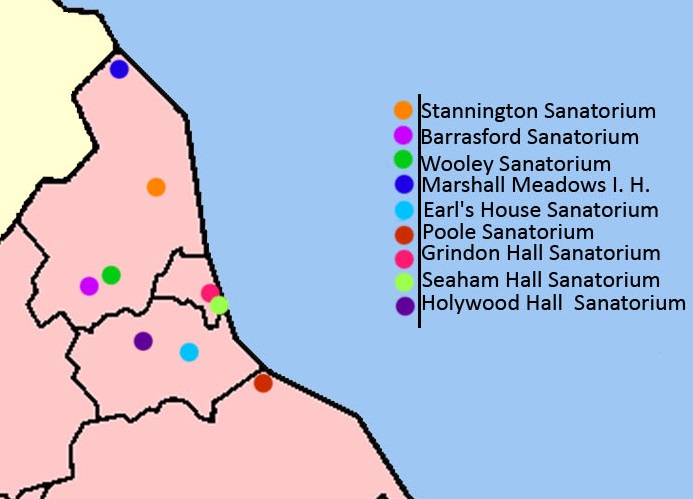
Barrasford, Northumberland.
Situated on the moors north of Hexham, Barrasford shared much of its history with Stannington. It was funded by the raising of a public subscription, helped by a large donation from an individual, in this case William Watson-Armstrong (later Baron Armstrong of Cragside). It too opened in 1907. However Barrasford was always intended to privately treat adult patients.
After notification became compulsory for TB in England in 1912 and government funds were given to councils to help the problem, sanatoria came into greater demand, and Northumberland County Council sought to obtain beds at existing sanatoria. Waiting lists were common at this time, with only 4% of British cases able to go to a sanatorium. By 1915 the County Council provided uninsured patients with 10 beds at Barrasford, with 9 for children at Stannington Sanatorium, and insured patients and their dependants went further afield to Blencathra San in Cumberland, The Royal Victoria Hospital for consumption, Woodburn Sanatorium, Edinburgh, and Felix House Sanatorium in County Durham. (NRO 3897, 1914, p.25; 1916, p.18). In 1915 the County Council eased some of the demand by leasing Fellside Sanatorium, Hexham, with 6 beds for uninsured patients. Though able to obtain some beds there and at Barrasford the County Council still found demand was high, so decided to set up their own sanatorium.
Wooley, Northumberland.
A site for a new sanatorium was found at Wooley, near Corbridge in 1913. Building was abandoned during WWI and began in 1919. Wooley opened in 1922 and initially took 104 patients, 16 of them children, and later added another ward for 36 men and boys. From the beginning it had a waiting list, and children were transferred to Stannington Sanatorium to make room for more adults. Indeed this movement was to continue; we have in our patient files one child transferred from and back to Wooley in 1947, and two children transferred from Wooley in 1953.
Patients going to Wooley were admitted by selection to prevent a large number of advanced cases depleting its resources. They gave out a booklet detailing what treatments and conditions patients were to expect and the rules they were to abide by. An important section covered expectoration, with patients required to ‘spit it into your sputum mug if on the wards or your flask if elsewhere’ (CC/CMS/PROPTB/2).
Wooley later gave discharged patients a leaflet stating that while they were not charged for treatment they were invited to make a contribution if they could. The ministry of health specified in 1922 that patients met part of the cost, though the County Council waived this for ex-servicemen and people with insurance, and a hardship fund paid for specific cases. However finances were often difficult for many patients, who shortened their stay to return to work. So Wooley provided a settlement for former patients that gave some patients light work and extra time to return to full health. The settlement grew vegetables, reared pigs and bred fancy rabbits, producing some champion specimens.
Poole, Cleveland.
Poole Sanatorium, near Middlesborough, was a children’s sanatorium and took many more Stannington patients than Wooley. Between 1946 and 1954 around 13 patients were transferred between Stannington and Poole. We are lucky to find some of the case notes and charts from Poole unusually mixed in with a patient’s Stannington Patient file.
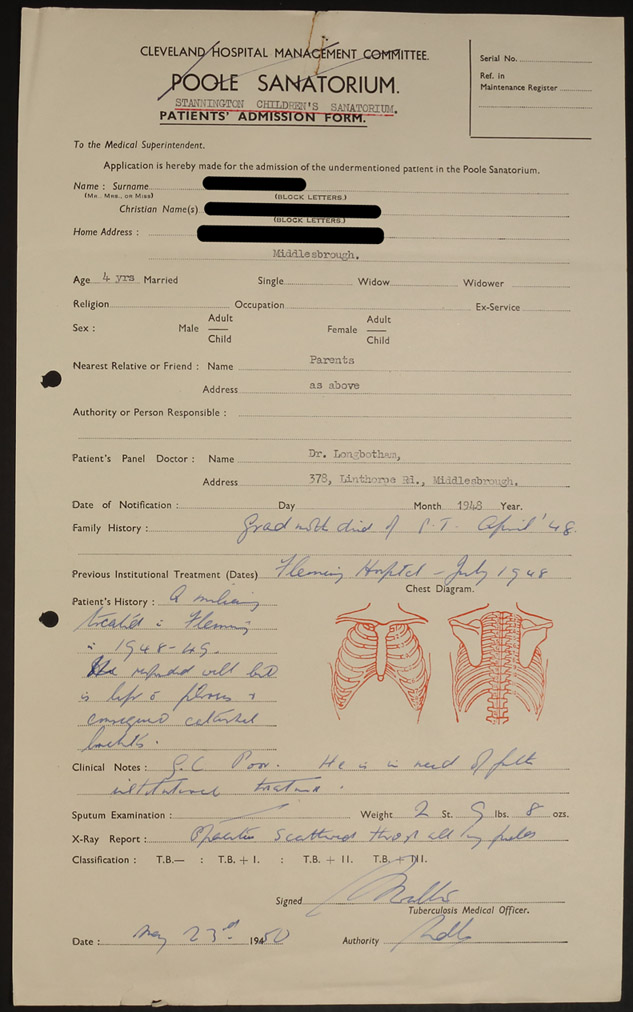
Correspondence between doctors at different hospitals was common. The letter below shows one of the main factors in the transfer of patients to Poole was the surgical team based there, as no surgery was done at Stannington after the 1930s when the last surgeon, Mr Johnson, left the sanatorium.

Earl’s house, County Durham.
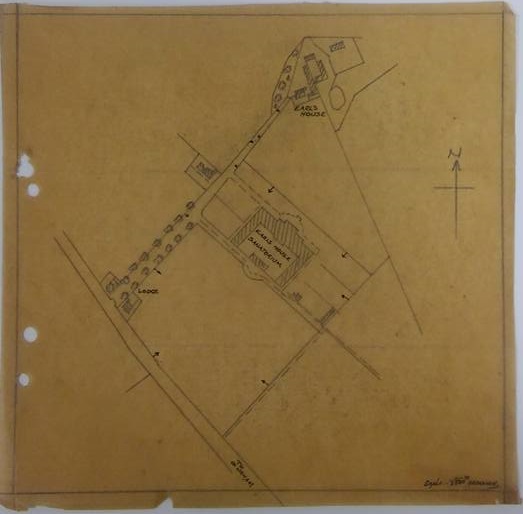
Previously used as a school, Earl’s House Sanatorium in County Durham was in use between 1928 and the 1960s. We have some files containing patient records from stays at Earl’s house, and the above drawing of Earl’s house, included in some of Dr Stobb’s papers.
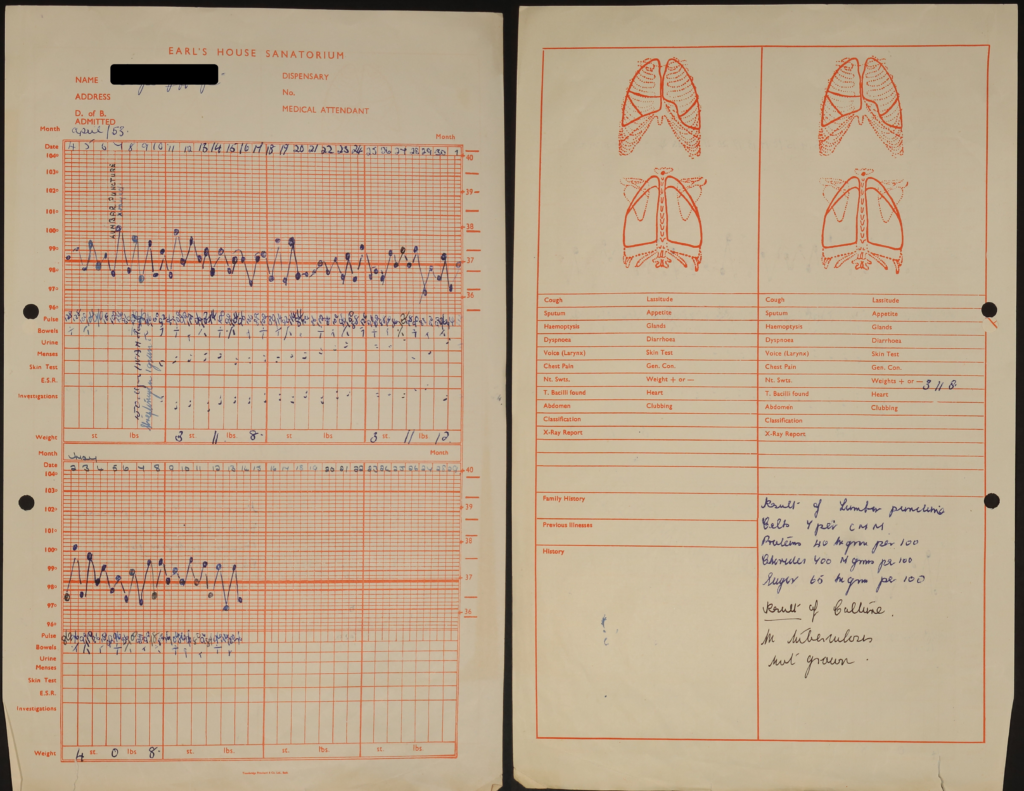
Others
Other sanatoria mentioned in the patient files include: Grindon Hall children’s sanatorium, Tyne and wear; Seaham Hall, Tyne and Wear; Whitehouse Sanatorium, Dorset; and Holywood Hall Sanatorium, County Durham. There were numerous isolation and other hospitals mentioned, mostly used for transfer, non-tuberculosis conditions or for serious illness and surgery as in the case of Newcastle General.

Convalesence homes used by the after-care committee’s patients include Papworth village settlement, Doxford hall holiday home, Preston Hall rehabilitation unit or colony, Whitton tower, Shoreston hall (NUM), Wallsend hospital for infectious diseases, Wilkinson Park, and one patient was sent in 1949 from Montana Hall to the Clinique Alexandre, Leysin, Switzerland (CC/CMs/PROPTBA/2).
Life in Sanatoria
Patients in local authority sanatoria, such as Marshall Meadows Isolation Hospital in Berwick and Wooley Sanatorium, were covered by the County Council’s tuberculosis after-care committee occupational therapist. Similarly to Stannington, they organised activities and handicrafts to occupy patients and speed their recovery. The after-care committee minutes for the 30th November 1950 mention patients using printing machines, reseating cane chairs, drawing and cabinet making. Embroidery was a common activity. One patient enjoyed a number of embroidery projects, and as he was dying wished he could finish the tablecloth he had been working on. Another child patient made toys, which were disinfected before they were given to other children. Items made by patients went on display in a shop window in Bedlington. On the 7th September 1950 the after-care committee gave grants towards a henhouse, greenhouse, and a billiard table for Wilkinson Park. They provided Christmas decorations for patients, gave a 5 shilling present from voluntary fund for each patient, and on 3rd March 1950 received a £320 donation for Christmas trees from the Newcastle central station Christmas tree fund (CC/CMS/PROPTBA/1).
The decline of Sanatoria
Sanatoria like these had their downfalls. Hiring and keeping staff was difficult, partly due to the stigma that came with Tuberculosis, and the rural nature of sanatoria. Wooley particularly found obtaining staff especially difficult through the war years, even despite a pay increase, arranging transport to Hexham and the ministry of labour finding domestic staff. Transport was difficult for patients too. A list of county patients’ journeys in the summer of 1946 (CC/CMS/PROPTBA/1) shows patients were moved long distances, such as Hexham to Norham and Berwick to Preston Hospital, North Shields. Letters in the Stannington patient files regularly mention bus times to the sanatorium. However it was the decline of TB that led to the closing of sanatoria like Stannington. However, perhaps this was short-sighted. Though anti-TB drugs were highly successful the disease is growing resistant, and there have been calls in the Lancet (2012) to bring sanatoria back.

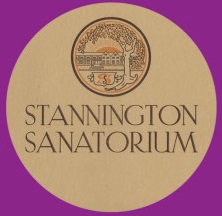
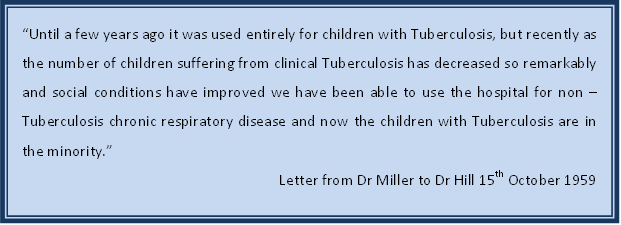
Not directly linked but I am trying to find a fever hospital which was run by the Earsdon Board around 1920 1940.
It was used as an isolation hospital. Small pox I think around 1930. Very small . After the closure where would the records go. Maybe preston Hospital North Shields? I have tried unsuccessfully to find any clue . The hospital was situated in a field called Earson Grange Nr, Wellfield School Whitey Bay. Northumberland.
Best regards Vivian.
Hi Vivian,
Thank you for your comment, we would suggest perhaps trying Tyne and Wear Archives who are more likely to hold anything relating to North Shields.
Many thanks.
Hello
I remember the Isolation Hospital in a field between Earsdon and Wellfield
It was a Corrugated Iron Building. It was visable from the train as it approached West Monkseaton station on the left hand side.
It was in a neglected state for many years and eventually removed from
the site!
I believe the concrete base is still visible as you walk across the fields!
Thank you for the information.
I was a patient at Stannington TB Hospital 1947-1949
I fell over in house and ended up with TB hip.
(2years old). I was treated by Dr Stanger, a wonderful man.
After leaving hospital had to go from Gateshead to Stannington (3 buses) to see him every year until I was 12.
…am now 72 and have had busy life: went to university, had two children who are now parents. Wouldn’t have made it without his treatment…..
I remember travelling from Linghorsley in Northumberland to Woolley sanitarium around 1950 to visit my mum. Where could I find any records of this please
Hello, unfortunately we don’t hold any patient records for Woolley Sanatorium.
Were can I find records on someone who died in a sanatorium 1945 from Byers green Durham Maud makepeace maiden name polson she was about 34
Hello, if the sanatorium was in Durham you would need to contact Durham Record Office to see if they can assist you. The email address is record.office@durham.gov.uk
I wonder if it’s possible to view my mother’s records at Barrasford Sanitorium about 1939 she was born in 1917 and was called Edna May Parkin (elliott). She died in 1984.
Thank you
Hello, I will pass your enquiry on to our researcher. All staff are currently working from home so have no access to our records but he can contact you and discuss if research can be carried out when we return to the office.
Trying to find information on Earsdon Isolation hospital or may have been called The Grange in Wellfield
Thank you for your enquiry. It will be passed on to our archives team.
My grandfather Ralph Miller Adams DOB 28.3.1909 was in the sanatorium at Woolley for six months in 1939. My dad tells me that he didn’t have TB but he had plural effusions. I would love to know if there is any way I could find his Woolley medical records.
Kind regards
Hello,
Could you please email your enquiry to archives@northumberland.gov.uk Thank you.
Hello there – I was wondering if Shoreston Hall, near Seahouses, was ever used as a TB Sanatarium during the late 40s to mid 50s. I also wondered if it was possible to have a patient based in Liverpool to be sent there.
Many thanks
Hello, would you be able to email your enquiry to archives@northumberland.gov.uk Thank you.
A friend, born March 1945, recalls being placed in a plaster bed for suspected TB spine in 1961 or 2 in Grindon Hall and is fruitlessly searching for an image of a plaster bed. Do you have such a thing in your archives? Thank you in anticipation.
Hello, could you please email your enquiry to archives@northumberland.gov.uk Thank you